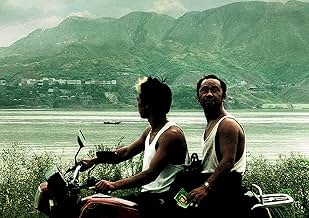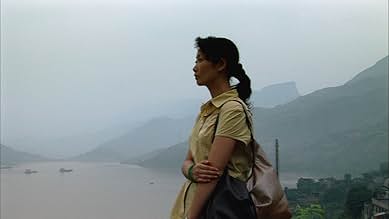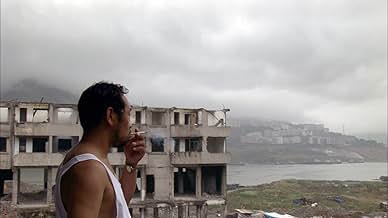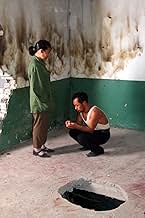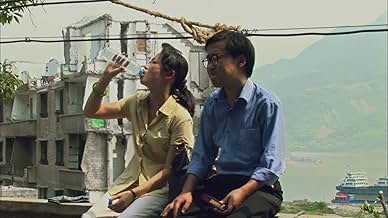VALUTAZIONE IMDb
7,3/10
7711
LA TUA VALUTAZIONE
Una città nella contea di Fengjie viene gradualmente demolita e allagata per far posto alla diga delle Tre Gole. Un uomo e una donna visitano la città per localizzare i loro coniugi separati... Leggi tuttoUna città nella contea di Fengjie viene gradualmente demolita e allagata per far posto alla diga delle Tre Gole. Un uomo e una donna visitano la città per localizzare i loro coniugi separati e diventare testimoni dei cambiamenti sociali.Una città nella contea di Fengjie viene gradualmente demolita e allagata per far posto alla diga delle Tre Gole. Un uomo e una donna visitano la città per localizzare i loro coniugi separati e diventare testimoni dei cambiamenti sociali.
- Regia
- Sceneggiatura
- Star
- Premi
- 15 vittorie e 14 candidature totali
Recensioni in evidenza
10enzino-1
Known previously as a documentary, and not as a romance, "Sanxia Haoren" ("Still Life") was the surprise and last film in Venice Festival (Italy) and not even the first one film of the young maker (he already had another movie in competition). Mr Jia shows us China just as it is nowadays. Not the power of huge works, or the beautiful scenery, just as the Dam on the Yangsi River nearby, but simple Chinese people, with simple problems, that do not know nothing such happiness (yet). It's heartbreaking, it's wonderfully filmed, it's like a superb painting. A simple masterpiece (and not only a Golden Lion). The surprise at Venice's Mostra. Catherine Deneuve, the French president of the jury of Venice, was very moved by Jia's work, the story told and the emotion of that film.
China's sixth generation director Jia Zhang-ke's recent Golden Lion winner at Venice is slightly more accessible to the general audience than his previous work, although Shijie (2004) has been heading generally towards that direction. Unlike Xiao Wu (1997), which is completely devoid of story or plot, Still Life at least has a story (in fact two) of sorts but, to Jia credit, stays away from the conventional Hollywood melodrama formula. The last thing we need is another Hollywood-look-alike movie made by a Chinese director who gives up what he is good at to impersonate a Hollywood director. There are already too many.
The story of the Three Gorges Dam begs to be told. Jia tells it from a micro, personal angle, by weaving two separate stories together, with the Three Gorges Dam project not just as a backdrop, but also as a subject of enquiry. In polarized contrast to the gorgeous tourism posters, Jia's camera shows the devastation along the Gorges in a way that almost reminds you of the ruins in Polanski's "The pianist". In the two unrelated stories, two people arrive in the same riverside town, a nurse looking for her husband who seems to have lost interest in her, and a coalminer searching for his wife who left him, taking with her their daughter.
These stories are told in Jia's usual minimalist style, but with pain sticking attention to details. Instead of the dialogue, it's the nuances, the body language, and even the framing of the shot that reveals. New to Jia's screen are moments of playful, surprising touches as if the director is saying "Hey, I can handle surreal too". The appropriate use of pop music from Hong Kong, Taiwan and the Mainland of China adds to the dimension and depth of the film.
True to his tradition, Jia films the life of ordinary people just as it is. The coalminer in Still Life is one in real life, and a relative of Jia. He even uses his real name Han San-ming. True to his tradition again, Jia uses only one professional actor, Zhao Tao, but she is so good that you can't tell her apart from the rest of the "cast" in terms of being an authentic, ordinary person that Jia might have just picked from a crowd in the street.
I miss Jia's earlier work such a Xiao Wu, for its uniqueness and detached, realistic depiction of lives of real people. On the other hand, I don't mind his introduction of conventional "entertaining" elements, so long as he stops before, way before, succumbing to the senseless scramble of the Chinese 5th generation directors to capture the Hollywood market. Many a soul has been sold for fame and fortune.
The story of the Three Gorges Dam begs to be told. Jia tells it from a micro, personal angle, by weaving two separate stories together, with the Three Gorges Dam project not just as a backdrop, but also as a subject of enquiry. In polarized contrast to the gorgeous tourism posters, Jia's camera shows the devastation along the Gorges in a way that almost reminds you of the ruins in Polanski's "The pianist". In the two unrelated stories, two people arrive in the same riverside town, a nurse looking for her husband who seems to have lost interest in her, and a coalminer searching for his wife who left him, taking with her their daughter.
These stories are told in Jia's usual minimalist style, but with pain sticking attention to details. Instead of the dialogue, it's the nuances, the body language, and even the framing of the shot that reveals. New to Jia's screen are moments of playful, surprising touches as if the director is saying "Hey, I can handle surreal too". The appropriate use of pop music from Hong Kong, Taiwan and the Mainland of China adds to the dimension and depth of the film.
True to his tradition, Jia films the life of ordinary people just as it is. The coalminer in Still Life is one in real life, and a relative of Jia. He even uses his real name Han San-ming. True to his tradition again, Jia uses only one professional actor, Zhao Tao, but she is so good that you can't tell her apart from the rest of the "cast" in terms of being an authentic, ordinary person that Jia might have just picked from a crowd in the street.
I miss Jia's earlier work such a Xiao Wu, for its uniqueness and detached, realistic depiction of lives of real people. On the other hand, I don't mind his introduction of conventional "entertaining" elements, so long as he stops before, way before, succumbing to the senseless scramble of the Chinese 5th generation directors to capture the Hollywood market. Many a soul has been sold for fame and fortune.
The movie tells two separate stories of two people. They are both from Shaanxi and take a long way to Fengjie to find their relatives. As they came to Fengjie, a 2000 year old city was going to submerge under water as the great Three Georges Dam was being built. Even though the media always tells great things about the Three Georges Dam, what the audience actually see is a dying town which is being demolished part by part. Along with the city is the destinies of poor people living here. People were forced to relocate and find another place to live and work. The movie is also very successful to depict the miserable living condition of poor people in the region. From here, another aspect of Chinese economic miracle is revealed as poor people find no way to get out of deadly spiral of poverty and have no choice but to move to other places such as Shaanxi to work as coal miners - a job as described in the movie can help them earn more money than their hometown but is also riskier as dozens of people die every year.
Another success of the film is the choice of music and songs that were played intermittently during the movie. In particular, the old song "Seung Hoi Tan" was used as a ringing tone for the phone of a local worker, perhaps as a reminder of old traditional value. On the other hand, "Mouse Love Rice" - a new rising love song at that time was singed passionately by the young kid marking the subtle transform in Chinese culture.
Another success of the film is the choice of music and songs that were played intermittently during the movie. In particular, the old song "Seung Hoi Tan" was used as a ringing tone for the phone of a local worker, perhaps as a reminder of old traditional value. On the other hand, "Mouse Love Rice" - a new rising love song at that time was singed passionately by the young kid marking the subtle transform in Chinese culture.
Reviewed at the North American premiere screening Tues. Sept. 12, 2006 at the Varsity 8 Theatre during the Toronto International Film Festival (TIFF).
I was lucky enough to be at TIFF screenings on Monday when it was announced that Sanxia Haoren was going to have a special one-time screening as a last minute addition to the Visions programme of TIFF 2006. I think the online tickets went fairly quickly and the theatre was packed with a considerable overflow of film writers & critics who had been unable to squeeze into the industry screening.
Sanxia Haoren has been given the title Still Life for international release, but the original Chinese title would seem to translate simply as Three Gorges Good People and it is in the vicinity of the dam's construction and the city demolitions and the people displacement entailed by it, that the film takes place. The film has a bookend plot of a miner Han Sanming (character's and actor's names are identical) who comes to the town of Fengjie to search for his estranged wife and child. The centrepiece story is that of a nurse named Shen Hong who is searching for her missing husband.
The dour faced Han Sanming is initially a cause of concern as it seems at the very start he is going to be swindled by tricksters on the river ferry but he soon shows that he can hold his own. We then think he is going to conned by a sarcastic motorcycle taxi driver who takes him to the location of his supposed house only for him to find it is now submerged under water. Things soon settle down for Han though as he finds lodging in a boarding house and work as a house demolition man on a crew with a brash young man who seems to have learned all his life lessons from the movies of Chow Yun Fat. Various humorous interludes (such as a young boy who sneaks cigarettes and roams around singing overly romantic songs which usually degenerate into an off-key screech by their end) and certain magic sequences (which I won't spoil) serve to bring comedy and wonder along the way. Several times the screen is seemingly chapter titled with the words "cigarette", "liquor", "tea" and "toffee", when these items occur during the plot, and any other meaning to this device eluded me. The journey of Shen Hong is similarly full of encounters with different characters on the way. I don't think the two stories actually intersected, but I may have been somewhat tired at this mid-way mark of TIFF as this screening went from 10:30 pm to 12:30 am.
The impression that the actors were perhaps simply playing versions of themselves was reinforced later in the week when I also caught the same director's documentary "Dong" which follows painter Liu Xiao-dong around locations at the Three Gorges Dam and it turned out that Han Sanming was actually one of the sturdy workmen that painter Liu was using for his models in a large multi-paneled painting of men. A blond-dye haired motorcycle taxi driver of Still Life makes a cameo appearance in Dong as well.
I found both of these films equally absorbing as they told stories of regular people in somewhat extreme life-changing situations and also that the 2 films complemented each other in a symbiotic way. Seeing one will enhance your appreciation of the other and vice versa. Both films are very deliberately paced but very lyrical and if you have an appreciation for slower paced film they are very rewarding. Also, if you did not have any concept of the magnitude of what is going on in the Three Gorges area, these films will give you a first hand view.
The director Jia Zhang-ke was not in attendance for the North American premiere, as he presumably was still in Venice celebrating his win of the Golden Lion for this film and 2 awards for the documentary.
I was lucky enough to be at TIFF screenings on Monday when it was announced that Sanxia Haoren was going to have a special one-time screening as a last minute addition to the Visions programme of TIFF 2006. I think the online tickets went fairly quickly and the theatre was packed with a considerable overflow of film writers & critics who had been unable to squeeze into the industry screening.
Sanxia Haoren has been given the title Still Life for international release, but the original Chinese title would seem to translate simply as Three Gorges Good People and it is in the vicinity of the dam's construction and the city demolitions and the people displacement entailed by it, that the film takes place. The film has a bookend plot of a miner Han Sanming (character's and actor's names are identical) who comes to the town of Fengjie to search for his estranged wife and child. The centrepiece story is that of a nurse named Shen Hong who is searching for her missing husband.
The dour faced Han Sanming is initially a cause of concern as it seems at the very start he is going to be swindled by tricksters on the river ferry but he soon shows that he can hold his own. We then think he is going to conned by a sarcastic motorcycle taxi driver who takes him to the location of his supposed house only for him to find it is now submerged under water. Things soon settle down for Han though as he finds lodging in a boarding house and work as a house demolition man on a crew with a brash young man who seems to have learned all his life lessons from the movies of Chow Yun Fat. Various humorous interludes (such as a young boy who sneaks cigarettes and roams around singing overly romantic songs which usually degenerate into an off-key screech by their end) and certain magic sequences (which I won't spoil) serve to bring comedy and wonder along the way. Several times the screen is seemingly chapter titled with the words "cigarette", "liquor", "tea" and "toffee", when these items occur during the plot, and any other meaning to this device eluded me. The journey of Shen Hong is similarly full of encounters with different characters on the way. I don't think the two stories actually intersected, but I may have been somewhat tired at this mid-way mark of TIFF as this screening went from 10:30 pm to 12:30 am.
The impression that the actors were perhaps simply playing versions of themselves was reinforced later in the week when I also caught the same director's documentary "Dong" which follows painter Liu Xiao-dong around locations at the Three Gorges Dam and it turned out that Han Sanming was actually one of the sturdy workmen that painter Liu was using for his models in a large multi-paneled painting of men. A blond-dye haired motorcycle taxi driver of Still Life makes a cameo appearance in Dong as well.
I found both of these films equally absorbing as they told stories of regular people in somewhat extreme life-changing situations and also that the 2 films complemented each other in a symbiotic way. Seeing one will enhance your appreciation of the other and vice versa. Both films are very deliberately paced but very lyrical and if you have an appreciation for slower paced film they are very rewarding. Also, if you did not have any concept of the magnitude of what is going on in the Three Gorges area, these films will give you a first hand view.
The director Jia Zhang-ke was not in attendance for the North American premiere, as he presumably was still in Venice celebrating his win of the Golden Lion for this film and 2 awards for the documentary.
The comment which was written before mine gives a great and brilliant explanation of the social problems and facts that involves this film, so I am not going to repeat it. I prefer to talk about another one of the most relevant aspects of this movie: the photography, magisterially directed by Yu Likwai. Sometimes one can have the impression to be watching a photo album, further than a movie. There are no bad or ugly photo-grams in this film. Every image contains a really fine sense of photography as an art, including superb landscapes, exiting colors, and intelligent compositions with everything and everybody in the right place, without unaesthetic gaps. A pleasure for eyes and soul.
Lo sapevi?
- QuizRanked second in French film magazine Cahiers du cinéma's top 10 list of the best pictures of 2007, tied with Inland Empire - L'impero della mente (2006) and Grindhouse - A prova di morte (2007).
- ConnessioniFeatures A Better Tomorrow (1986)
I più visti
Accedi per valutare e creare un elenco di titoli salvati per ottenere consigli personalizzati
- How long is Still Life?Powered by Alexa
Dettagli
Botteghino
- Budget
- 10.000.000 CN¥ (previsto)
- Lordo Stati Uniti e Canada
- 76.983 USD
- Fine settimana di apertura Stati Uniti e Canada
- 12.744 USD
- 20 gen 2008
- Lordo in tutto il mondo
- 2.504.465 USD
- Tempo di esecuzione1 ora 51 minuti
- Colore
- Mix di suoni
- Proporzioni
- 1.78 : 1
Contribuisci a questa pagina
Suggerisci una modifica o aggiungi i contenuti mancanti





